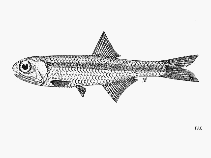Stolephorus andhraensis Babu Rao, 1966
Andhra anchovy
Ajouter votre observation dans Fish Watcher
| Native range |

|
| This map was computer-generated and has not yet been reviewed. |
| Stolephorus andhraensis AquaMaps Data sources: GBIF OBIS |
Envoyez vos Photos et vidéos
Pictures | Images GoogleStolephorus andhraensis
Photo de FAO
Pictures | Images GoogleStolephorus andhraensis
Photo de FAO
Classification / Names Noms communs | Synonymes | Catalog of Fishes(Genre, Espèce) | ITIS | CoL | WoRMS | Cloffa
> Clupeiformes (Herrings) > Engraulidae (Anchovies) > Engraulinae
Etymology: Stolephorus: Greek, stole, -es = garment + Greek, pherein = to carry (Ref. 45335).
Eponymy: This is a toponym; it refers to the state of Andhra Pradesh, India, the type locality. (Ref. 128868), visit book page.
Etymology: Stolephorus: Greek, stole, -es = garment + Greek, pherein = to carry (Ref. 45335).
Eponymy: This is a toponym; it refers to the state of Andhra Pradesh, India, the type locality. (Ref. 128868), visit book page.
Environment: milieu / climate zone / depth range / distribution range Écologie
marin pelagic-neritic; profondeur 0 - 50 m (Ref. 189). Tropical; 22°N - 15°S, 78°E - 148°E (Ref. 189)
Distribution Pays | Zones FAO | Écosystèmes | Occurrences | Point map | Introductions | Faunafri
Indo-Pacific: eastern Indian Ocean (eastern coasts of India around Waltair, but perhaps along most of the coast) and western Pacific (Singapore and Gulf of Papua, but presumably between).
Taille / Poids / Âge
Description synthétique Clés d'identification | Morphologie | Morphométrie
This species is distinguished by the following set of characters: gill rakers 33-37 (35) in first gill arch with 14-16 (modally 14) in upper series, 19-21 (21) in lower series; gill rakers 26-29 (29) in second gill arch, with 8-11 (10) in upper and 16-19 (19) in lower series; gill rakers 17-19 (19) in third gill arch with 7-8 (8) in upper and 10-11 (10) in lower series; gill rakers 14-16 (14) in fourth gill arch with 5-8 (6) in upper and 8-9 (8) in lower series; branchiostegal rays 10-11 (11); upper jaw long, posterior tip slightly short of or just reaching posterior border of opercle; without predorsal scutes; pelvic scute no spine-like projection; posterior border of preopercle is indented, concave; posterior tip of depressed pelvic fin does not reaching to vertical through dorsal-fin origin; anal-fin origin just below eighth to tenth dorsal-fin ray origin; length of caudal peduncle, 16.9-19.9% of SL, of pectoral fin, 13.2-14.4% of SL and of pelvic fin, 7.4-8.9% of SL. Colouration: with a pair of dark patches behind occiput without a following pair of dark lines; absence of black spots below eye or on lower-jaw tip (Ref. 124189).
Body shape (shape guide): elongated; Cross section: compressed.
Body shape (shape guide): elongated; Cross section: compressed.
Schooling species occurring in coastal waters (Ref. 189, 75154). Eggs are oval, without a knob. More material and data needed.
Life cycle and mating behavior Maturité | Reproduction | Frai | Œufs | Fécondité | Larves
Référence principale
Upload your references | Références | Coordinateur | Collaborateurs
Hata, H., S. Lavoué and H. Motomura, 2020. Stolephorus acinaces, a new anchovy from northern Borneo, and redescription of Stolephorus andhraensis Babu Rao, 1966 (Clupeiformes: Engraulidae). Mar. Bio. 50:102. (Ref. 124189)
Statut dans la liste rouge de l'IUCN (Ref. 130435: Version 2024-2)
Préoccupation mineure (LC) ; Date assessed: 28 February 2017
CITES
Not Evaluated
Menace pour l'homme
Harmless
Utilisations par l'homme
Pêcheries: commercial
FAO - Publication: search | FishSource |
Plus d'informations
Trophic ecology
Food items (preys)
Composition du régime alimentaire
Consommation alimentaire
Food rations
Prédateurs
Food items (preys)
Composition du régime alimentaire
Consommation alimentaire
Food rations
Prédateurs
Ecology
Écologie
Écologie
Population dynamics
Paramètres de croissance
Max. ages / sizes
Length-weight rel.
Length-length rel.
Fréquences de longueurs
Mass conversion
Recrutement
Abondance
Paramètres de croissance
Max. ages / sizes
Length-weight rel.
Length-length rel.
Fréquences de longueurs
Mass conversion
Recrutement
Abondance
Life cycle
Reproduction
Maturité
Maturity/Gills rel.
Fécondité
Frai
Spawning aggregations
Œufs
Développement de l'œuf
Larves
Dynamique des populations larvaires
Reproduction
Maturité
Maturity/Gills rel.
Fécondité
Frai
Spawning aggregations
Œufs
Développement de l'œuf
Larves
Dynamique des populations larvaires
Anatomy
Surface branchiale
Brain
Otolith
Surface branchiale
Brain
Otolith
Physiology
Body composition
Nutrients
Consommation d'oxygène
Type de nage
Vitesse de nage
Visual pigments
Fish sound
Diseases & Parasites
Toxicity (LC50s)
Body composition
Nutrients
Consommation d'oxygène
Type de nage
Vitesse de nage
Visual pigments
Fish sound
Diseases & Parasites
Toxicity (LC50s)
Genetics
Génétique
Heterozygosity
Héritabilité
Génétique
Heterozygosity
Héritabilité
Human related
Aquaculture systems
Profils d'aquaculture
Souches
Ciguatera cases
Stamps, coins, misc.
Aquaculture systems
Profils d'aquaculture
Souches
Ciguatera cases
Stamps, coins, misc.
Outils
E-book | Guide de terrain | Clés d'identification | Générateur de fréquences de longueur | Outil de dynamique de population | Carte par point | Classification Tree
| Catch-MSY |
Articles particuliers
Télécharger en XML
Sources Internet
AFORO (otoliths) | Aquatic Commons | BHL | Cloffa | BOLDSystems | Websites from users | FishWatcher | CISTI | Catalog of Fishes: Genre, Espèce | DiscoverLife | ECOTOX | FAO - Publication: search | Faunafri | Fishipedia | Fishtrace | GenBank: génôme, nucléotide | GloBI | Google Books | Google Scholar | Google | IGFA World Record | MitoFish | Otolith Atlas of Taiwan Fishes | PubMed | Reef Life Survey | Socotra Atlas | Arbre de Vie | Wikipedia: aller à, chercher | World Records Freshwater Fishing | Zoobank | Zoological Record
Estimates based on models
Preferred temperature (Ref. 123201): 27.7 - 29.2, mean 28.6 °C (based on 838 cells).
Phylogenetic diversity index (Ref. 82804): PD50 = 0.5000 [Uniqueness, from 0.5 = low to 2.0 = high].
Bayesian length-weight: a=0.00501 (0.00220 - 0.01140), b=3.14 (2.96 - 3.32), in cm total length, based on LWR estimates for this Genus-body shape (Ref. 93245).
Niveau trophique (Ref. 69278): 3.2 ±0.4 se; based on size and trophs of closest relatives
Résilience (Ref. 120179): Haut, temps minimum de doublement de population inférieur à 15 mois (Preliminary K or Fecundity.).
Fishing Vulnerability (Ref. 59153): Low vulnerability (10 of 100).




